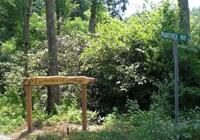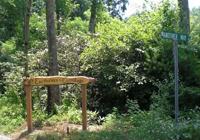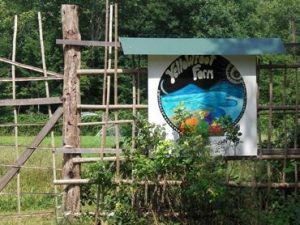Author: Arjuna da Silva
Published in Communities Magazine Issue #153
Permaculture stole my community—or perhaps just borrowed it.
To understand how that happened, you need to know the backstory…
Before Earthaven
Before joining the Earthaven founders in western North Carolina (where I now live with about 60 other members on 320 acres of land), I helped start several small, short-lived intentional communities around the country. Each one in its own way was a transformational social/spiritual/cultural endeavor. We lived closer to Earth than we had in our cities and suburbs, but we didn’t make sustainability or food production our focus, and we’d never heard of permaculture In each case we fell apart, mostly because we weren’t supporting ourselves from the land and couldn’t find jobs in our local rural areas.
Later, in Gainesville, Florida, I was part of an extended community made of up to 10 households, with several collective businesses to keep everyone afloat, and with a shared commitment to a spiritual path. It was here that I first encountered the term “permaculture,” and was intrigued, though I still knew nothing about it.
After the Gainesville group had scattered, I went land-searching with another group from that same spiritual path. Permaculture came up as the land use and design system we would need to put our social-cultural vision on the ground. By this time, it seemed to me that everyone knew about permaculture—unknown just a couple decades before, it had become the “happening thing” for communities, land-wise, just as consensus was the happening thing, governance-wise.
Earthaven: The Dream Evolves
When the dream of creating Earthaven first began, my two closest friends were involved. They kept me apprised of the visionary and land-search work going on, so a few yeas later when it came time for me to leave Florida, we showed up at the formal invitational meeting together. (The name Earthaven came later.)
That meeting and the subsequent first few years of Earthaven’s existence (starting in 1994) were like magic. The people who gathered to take up the mission of establishing eco-spiritual community outside of Asheville, North Carolina became my best friends. It was also reassuring to discover that two of my cofounders were permaculture designers who would, from my perspective, be able to help us rubes get some important things right.
Little did I know that permaculture was more than a design system—it’s a movement for recreating society in a practical and ethical way. It is so enthralling in its breadth and accessibility that many other more ephemeral goals wind up in the back row while the huge learning curves in land-based living (for us: clearing land, utilizing timber, building homes, developing basic infrastructure, learning to farm, raise animals, raise children in the woods, etc.) seem to take up all the available focus a person can muster.
Okay, I’m exaggerating. We have not abandoned commensurate skill development in communication and social contracts, interpersonal and inner work, but it has mostly gotten the energy left over from all the other more primary endeavors. And lately it gets a lot more attention than ever. But that’s after a few long years of what now seems to have been a terrible imbalance, years when I wondered where I’d come to and how I’d gotten abandoned here!
The first decade or so developing property on a shoestring budget requires enormous focus on support systems for living a moderately modern lifestyle. Whereas our first few years getting to know each other while sketching out our dreams and plans (and living for the most part in town) were deeply infused with what I’ll call higher-vibe activities like meditation, dancing, singing, and ceremony, as we became immersed in the ordeals of infrastructure development and land use our focus subtly but inexorably shifted. We were teaching each other as well as folks from around the world how to apply permaculture to a forested habitat; there were certification courses turning out dozens of new “permies” every year; we were learning and teaching natural building methods, gathering courage to begin some serious land clearing for agriculture. Meanwhile, the higher-vibe activities slipped into the background, while rest and relaxation and a bit of good ol’ community socializing seemed to be all we could really muster to balance out the workload.
Stranded in Permaculture Heaven
One day, several years into the unexpectedly solo project of building an earth-and-straw house, I caught myself wondering how I could have gotten to the place where I’d traded in my normal conversations about subpersonalities and form-and-emptiness for a daily litany of plant, soil, weather, and energy data. Wah! Where did everyone go? How come they left me here in permaculture heaven? (Almost every one of my friends from Earthaven’s founding stage never made it to the level of pioneer, and I’m still waiting to share my building site with others.)
If I didn’t love this land, if I didn’t love this lifestyle, if I didn’t love this house, if I didn’t feel close to a small circle of friends here, if I hadn’t learned to enjoy the satisfaction of being a homesteader—I’d go start me another community and make sure permaculture just stayed in its place! I’d know to get all the founders to sign promissory notes giving the community the next 10 years of their lives. (How to do that? How about a deposit refundable after 10 years?) I’d know to write down all the visionary and spiritually woo-woo things we’d say in the beginning, even if that new group also thought they were so obvious and “transparent” there wouldn’t ever be a need to know “what the founders meant.”
Moving Toward Balance
It may be that Earthaven Ecovillage is the right model in the right place at the right time to help folks in this lunatic culture get hold of a replicable example of sane living in obedience to natural laws. Hopefully, it will also come to pass that my discontent will settle out and I’ll make a graceful peace with the world of land use and permaculture gridlock, and find myself focusing at long last again on life on the inside of reality.
Things could be changing. New folks have stepped up in leadership and are holding forth with a more powerful spiritual presence. Tools for stronger connection are being presented and some are taking hold. Lately folks I’ve given tours to seem spiritually and socially quite wise as well as savvy about alternative technologies. Maybe I’ve just been unnecessarily impatient. Maybe Spirit just let permaculture borrow my community so it could set itself up on a large enough scale in the US to be noticed. Maybe balance is right around the corner.
As we celebrate our 17th year on the community road together, despite or perhaps integral with all the surprises, disappointments, and losses, I have come to see that the container—the crucible—of community still has given me opportunities only it can provide to see myself as others might see me, to encounter my foibles and flaws in stark relief and plenty of empathy, and to quietly, sometimes uproariously, etch my way home to stillness and the internal balance that is yearning to be seen and felt on the outside.



















3rdRevision
How come you’re building a mud/straw house in a damp climate? Sounds like that might add to your suffering.
Arjuna da Silva replies:
Dear Friend,
Thanks for your question about building with earthen and straw materials in a damp climate. We certainly wondered about that ourselves. But then we discovered that cob–one of the oldest forms of mud masonry–has been the wall system of many a multi-hundred year old cottage in Devon and other somewhat dampish places in the British Isles. We heard about a cob cottage in New Zealand that had lost its roof and after twenty-five years the walls were still standing. (Nice of them to leave it like that for us!) The key to building with these materials is that you need good moisture barriers, including “”a good cap and boot””–a wide roof overhang and a non-wicking foundation. Thick walls like these breathe, but with mostly lime plasters, they don’t seem to mold at all. We did our homework and sprung for oil-based products when we were sure we needed them. So we have no moisture seeps. One thing we did more of in the beginning was work with bermed walls. Those need the greatest care–perhaps concrete if not plastic. I’m thrilled with the house. Come visit! We do tours and do a dream-your-own-natural house seminar once a month. Please look at http://www.naturalbuildingschool.com.
Sincerely,
Arjuna da Silva
Earthaven